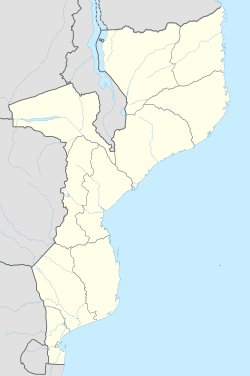Beira (Mozambique)
| Beira | |
|---|---|

Beira Cathedral
|
|
| Coordinates: 19°50′S 34°51′E / 19.833°S 34.850°E | |
| Country |
|
| Provinces | Sofala Province |
| Founded | 1887 |
| City Status | 1907 |
| Government | |
| • Mayor | Daviz Simango |
| Area | |
| • Total | 633 km2 (244 sq mi) |
| Elevation | 14 m (46 ft) |
| Population (2007 census) | |
| • Total | 436,240 |
| • Density | 690/km2 (1,800/sq mi) |
| Climate | Aw |
Beira is the third largest city in Mozambique. It lies in the central region of the country in Sofala Province, where the Pungwe River meets the Indian Ocean. Beira had a population of 412,588 in 1997, which grew to an estimated 546,000 in 2006. It holds the regionally significant Port of Beira which acts as a gateway for both the central interior portion of the country as well as the land-locked nations of Zimbabwe, Zambia and Malawi. Beira was originally developed by the Portuguese Mozambique Company in the 19th century, and directly developed by the Portuguese colonial government from 1947 until Mozambique gained its independence from Portugal in 1975.
Beira is located on the Mozambique Channel, an arm of the Indian Ocean located between Madagascar and Mozambique. The city sits north of the mouth of the convergence of two major rivers of Mozambique: the Buzi River and the Pungwe River. The Buzi crosses 250 kilometres (160 mi) across Manica and Sofala provinces to form a wide estuary. The Pungwe crosses 400 kilometres (250 mi) from the Eastern Highlands of Zimbabwe also through Manica and Sofala provinces to Beira.
The city was established in 1890 by the Portuguese and soon supplanted Sofala as the main port in the Portuguese-administered territory. Originally called Chiveve, after a local river, it was renamed to honor the Portuguese Crown prince Dom Luís Filipe who, in 1907, was the first member of the Portuguese royal family to visit Mozambique. Traditionally the Portuguese Crown prince carried the title of Prince of Beira, a historical province of mainland Portugal. The Portuguese built the port and a railway to Rhodesia, Portuguese families settled in the newly founded locality and started to develop commercial activities. With the growth of the village, in 1907 the Portuguese Crown elevated Beira to the status of city (cidade). Headquarters of the Companhia de Moçambique (Mozambique Company) from 1891, the city's administration passed from the trading company to the Portuguese government in 1942. In 1966, the construction of a new railway station was completed. Before Mozambique's independence from Portugal, as a city of Portuguese Mozambique, Beira was noted for its well-equipped seaport, one of the major facilities of its kind in all East Africa, tourism, fishing and trade. The city prospered as a cosmopolitan port with different ethnic communities (Portuguese, Indian, Chinese, Bantus such as the Sena and Ndau) employed in administration, commerce, and industry. A large English-speaking population was the result of being a favourite holiday destination for white Rhodesians. One reminder of this is the Grande Hotel, built by the Portuguese, near the shore of the Indian Ocean. By 1970, the city of Beira had 113,770 inhabitants.
...
Wikipedia

